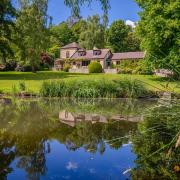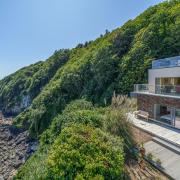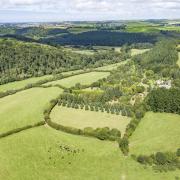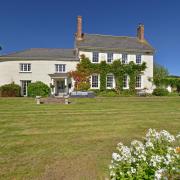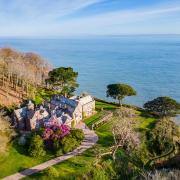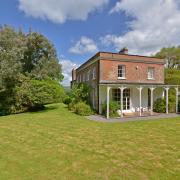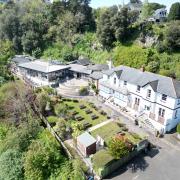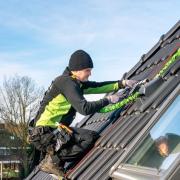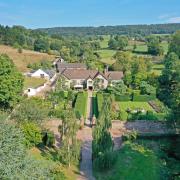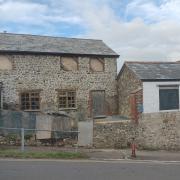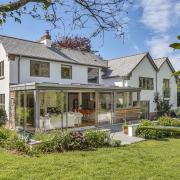Susser Sparrow has fused the clean and simple interior style of her native Denmark in this essentially English barn conversion. Words Malcolm Twigg, photographs Neville Stanikk.
By any stretch of the imagination, Susser Sparrow has led a very interesting life - most of it of her own choosing. She doesn't seem the sort of person who lets life just happen. Born and raised in Denmark, when she left school she went travelling and ended up in Brussels where she learned catering, and went on to cook for the Danish Ambassador there for four years.
She then decided to come to England to try her catering skills over here and, through her contacts in the various embassies, got a toehold in catering for diplomats and the ex-pat Danes in London who - if you can believe it in this taxed-to-the-hilt country of ours - live here for tax reasons. By this time she had met and married her husband, Toby, and then, with their two small children, moved to India for a couple of years while Toby set up his own IT company.
After moving back to London, Susser decided to give up the hectic, pressured world of catering in order to teach, but mostly to concentrate on raising her family, meanwhile taking a two-year course in interior design. Then, six years ago, they decided to quit the rat-race and move to Devon.
They are now settled just outside the idyllic little village of Morchard Bishop near Crediton, living in a converted goat barn, next door to Toby's parents, down a long, steep and rutted farm track right in the middle of the Mid-Devon countryside, where the only sounds to be heard are the clucking of the in-law's chickens and, lately, the frenzied chomping of three piglets that Susser and Toby are raising for the pot.
"It couldn't be more different from where we lived in Camberley," Susser told me. "There we had a railway line at the bottom of the garden and a road in front." At the back of the garden now they have pigs and a vegetable plot, and at the front a tract of Devonshire countryside that most people would give an arm and a leg for. Indeed, the garden itself is not so much a garden as an extension of the countryside that stretches for miles around. Who needs tended flower beds when nature's flower bed is just beyond the hedge?
"The first few nights we spent here I couldn't believe how quiet it was - it was almost spooky," Susser recalled. "Now, we don't want to be anywhere else, even though the children have to spend a couple of hours each day travelling to and from school." Now that they are at senior school, it leaves Susser free to get on with her interior design business. She designs blankets that are then made up in Scotland on old-fashioned looms, to a colour range specially selected by her to accord with her Scandinavian tastes. Vibrant is a word that is much over-used, but vibrant is what Susser's colours are.
"Colour is a very important part of Scandinavian life," Susser explained. "I find that we have a very different approach to using colour from English people," she said. "We have a much clearer quality of light in Scandinavian countries and we like to have everything light and bright. In most houses in Denmark the interiors of houses are white, with light curtains and furnishings, enlivened by a splash of colour. That is what my blanket range sets out to do. If you have a home with a completely neutral background you can change the entire look and mood instantaneously just by introducing a bright colour with a throw, a vase, some flowers and, perhaps, a rug or two." That, in fact, was what she was intending to do to the lounge very shortly - a cheap and very effective way of transforming a look.
Susser's home was once a goat barn belonging to the farm next door and it had already been converted from a ruinous shell when they bought it and moved in. "It was in such a state, apparently, that the previous owners had difficulty in finding a builder who would touch it," Susser said. However, find one they did, and the result is a four-bedroom family home on three levels, which, by all accounts, is extremely economical to run.
"Some of the old walls are cob, which retain heat in the winter and keep the house cool in the summer," she explained.
"In fact, over the past couple of winters we've hardly had to spend anything on heating at all since the wood-burning stove in the lounge heats the entire house."
The family pets certainly approve (they have two flat-coated retrievers - Bramble and Nettle - and Socks the cat) who, more often than not, can be found stretched out in front of one or other of the heat sources.
"When we first moved in, everywhere was dark wood, even in the kitchen and one of my first jobs was to paint as much as I could white, including the beams," Susser said. Painting exposed beams might sound sacrilegious to the more traditionally minded British, but to the Scandinavian eye having dark colours around is oppressive.
Today, the house presents an appearance that is somewhere between the two extremes. "It's quite interesting how it has turned out, actually. Although I think the décor is quite Scandinavian, Danish friends think it is typically English."
This is not your typical English barn conversion, more a very comfortable family home containing treasured pieces of furniture collected on the family's travels around the world. The style is all in the colour. And this changes at a whim.
Susser and Toby's en-suite bedroom is up a short flight of stairs directly from the lounge (which itself is open-plan to the kitchen), and the rest of the bedrooms are accessed from another staircase at the opposite end of the lounge. Both children have spacious bedrooms crafted amongst the truss work of the old barn, and share a study/chillout room off the main staircase, which they have decorated themselves.
It's entirely their own space and Susser never goes up there - perhaps because it's difficult of access because you have to shimmy your way in without the benefit of stairs or steps. It's a bit of an adventure for kids, however, and somewhere to entertain their friends. The guest room is at the top of the staircase and has enough space to be converted into a fully functioning separate suite, especially if Susser puts into operation her plan to install a decking area outside, and provide a separate access to it.
Although they are happy enough with things as they are at the moment, there is still a lot of scope for further conversion and improvement. Toby's office, for instance, could be converted into an entirely separate bedsit. But there's quite enough going on at the moment in other directions anyway. Susser's interior design business isn't the only one being carried on here. Toby has his own office in a converted tool shed where he carries out his IT work and also administers his own patented product: The Wellie Box. Inspired by the ever-present dirty wellie boots of country living, this is simply a storage box, also serving as a seat, with in-built boot jacks for helping remove the boots, thus keeping the floors clean and everything tidy. Frankly, no country house should be without one and I can't think why no one came up with the idea before.
I was actually sorry to leave Susser and Toby to it. It isn't often you meet people who seem thoroughly at home in their surroundings, but perhaps that's what living in Morchard Bishop does for you.
For further information on Just Blankets and the Wellie Box (01363 877768, www.justblankets.co.uk and www.innovayta.com;



